2017 Land Rover Discovery Sport vs Mercedes GLC 220d comparison
Land Rover has plonked its excellent new diesel engine into the Discovery Sport. But can it dethroning the Mercedes-Benz GLC?
Published on Jul 19, 2017 07:00:00 AM
82,572 Views
Follow us on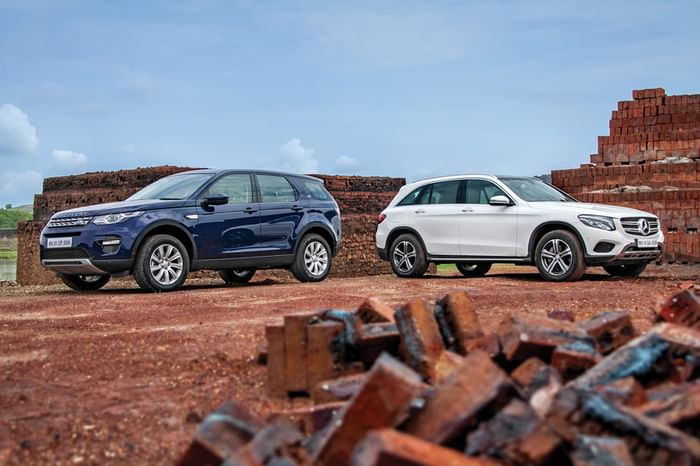
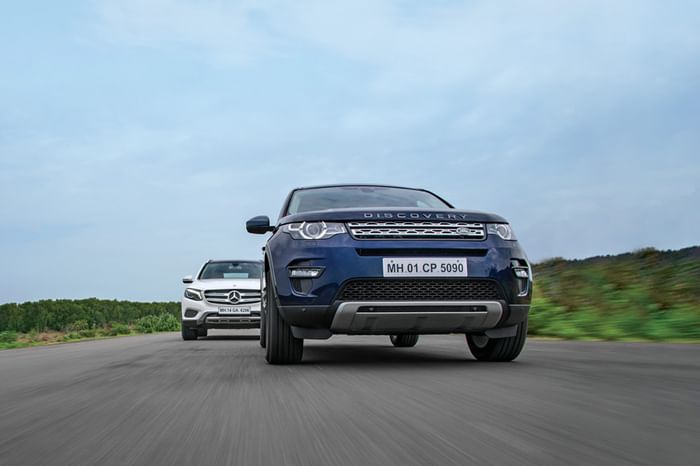
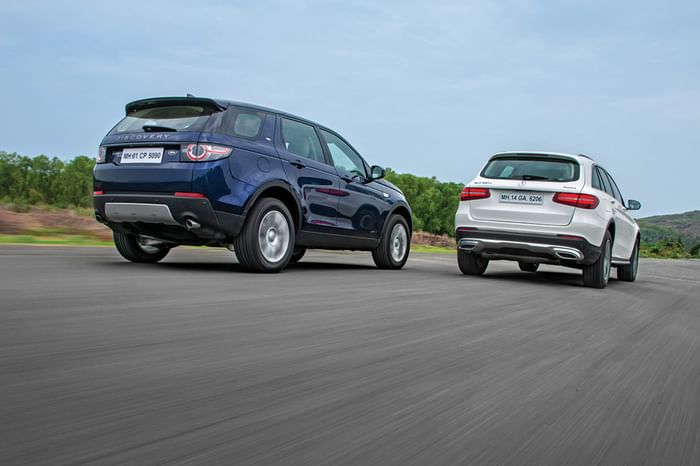

Let’s get right down to it. The last time the diesel versions of these two SUVs met, the Land Rover had one big disadvantage – it used JLR’s old-generation 2.2-litre diesel engine. That’s changed, now that the company’s new ‘Ingenium’ 2.0-litre diesel has been introduced. In this HSE trim, its outputs may still be shy of the Mercedes, but, in the real world, the new motor has made a big difference in the way the Discovery Sport drives. Is that enough to let it edge ahead of the luxurious GLC? Let’s find out.
TWO KINDS OF SUV
The Disco Sport may be a lot sleeker-looking than the boxy Freelander it replaced, but it is still very much a Land Rover. There are rugged bits all around – a bit of grey cladding around the base, that famous grisly grille, bash plates at the front and rear and those huge headlamps and tail-lamps with the round ‘compass’ motif, meant to denote a go-anywhere ability. Even the fact that you can see the suspension bits through the huge wheel wells tells you this SUV has more of a tough inclination.
| Land Rover Discovery Sport Price, Mileage, Specifications, Features and Variants | |
|---|---|
| Brand | Land Rover |
| Model Name | Discovery Sport |
| Land Rover Discovery Sport Price | ₹ 78.58 - 80.27 lakh |
| Land Rover Discovery Sport Range/Mileage | NA |
| Land Rover Discovery Sport Specifications | SUV | 5 doors | 7 seats View All Specs |
| Land Rover Discovery Sport Features | LED headlight | 11.4-inch Touchscreen display | 7 airbags View All Features |
| Land Rover Discovery Sport Variants | Dynamic SE 2.0 Petrol | Dynamic SE 2.0 Diesel View All Variants |
The GLC is pretty much the opposite; more a crossover in its design. Much like the C-class it’s based on, the styling is soft, made up entirely of swoops and curves. It’s very elegant but still has a few touches that grab your attention, like the large three-pointed star on the grille, the smooth LED headlamps and scuff plates, front and rear, finished in chrome, no less. Its stance is a bit more hunkered down, and it looks like it has at least some sporty pretensions under that skin.
This diversity carries on inside the cabin, where the Land Rover has a robust, no-nonsense look. The controls are simple, large and clearly laid out, but they do have a slightly lacklustre feel for a luxury car. Similarly, the InControl Touch infotainment system is well-featured, but it just feels a little slow and clunky by modern standards. You will like the chunky metal door handles and the way everything feels built to survive the apocalypse. But, overall, there’s not a lot of wow factor in here, and the materials just don’t feel quite so rich.
Enter the GLC and again, it’s the opposite. No pretence of toughness here; it’s all luxury. From the large slabs of wood to the brushed-metal AC vents to the knurled switches, it all feels properly classy. There are some odd bits, like the screen that feels too small for its frame and the rather plain-looking dials, but apart from that, it gives a sense of richness that the Discovery just can’t hope to. This infotainment system isn’t great either though, with a not-very-intuitive system operated by a rotary dial. It’s been improved in newer Mercs, so that’s something we’ll have to look forward to with the facelift.
SEATED DEBATE
The key difference here is that the Discovery Sport, in this spec, is a 5+2 seater, whereas the Mercedes is a five-seater. The third row in the Land Rover is nominal at best and could seat two small occupants in a pinch, and if so, then luggage space is seriously limited, so perhaps it’s best to keep them folded into the floor, which liberates a huge luggage area. The Mercedes has a decent-sized boot too, but the spare tyre that sits in this space takes away most of it. Over at the front, the Disco Sport’s seats give you a superb view of the car’s extremities, which again reinforces its off-roading SUV credentials. The GLC, by comparison, seats you relatively low down and you have a tall dashboard cowl to peer over. The feeling is almost sporty, but more of being absolutely cocooned in luxury. The seats are large and soft and will be more suitable to a variety of body types, whereas, in the Discovery, they’re a bit slimmer and on the firmer side, but by no means uncomfortable.
On to the second row and in the Discovery, you’ll find it’s not as high a step up into the cabin as you thought. The bench is wide enough for three, with decent legroom when it’s slid fully forward, and immense legroom when it’s slid fully back; it can even be reclined. The Mercedes’ seat doesn’t slide, but it has pretty good legroom as is, and, though the seat cushioning is more plush, it’s good for just two. Thigh support is lacking slightly here, and it is in the Land Rover too, but sliding the latter’s seat all the way back alleviates this quite a bit. Both cars open up their cabins further with panoramic sunroofs, but while the Merc’s is split and opens at the front, the Disco’s is one continuous piece of glass that doesn’t open.
BRAWN TO BE WILD
So in what way is JLR’s new Ingenium diesel motor better than its old 2.2-litre motor? Refinement, for a start – at start-up, idle and any revs, it tested quieter than the old car. You certainly don’t get that great big ‘boom’ in the mid-range and, generally speaking, it’s far more refined. Compared to the GLC though? They’re pretty evenly matched, with the Merc feeling a bit quieter at low revs, but then waking up with a more clattery noise. The Ingenium motor, on the other hand, can be heard more of the time, but the sound it makes is more of a buzz that isn’t as obvious.
Similarly, when it comes to power delivery, the new Land Rover motor is miles smoother than its predecessor, which had identical outputs of 150hp and 382Nm in its HSE spec, and the power seems more focused at the low-to-mid range and comes in one huge lump. This makes it excellent at setting off the line and it has plenty of pep for pottering about town, but the flip side is that it’s lost some of its predecessor’s top-end whack. The GLC, with its 170hp and 400Nm, spreads its power across a wider band. It’s much freer revving and, so, while you don’t get that low-down punch you get from the Disco, it pulls strongly thereafter, all the way to its redline. Against the clock, it was really no contest – the GLC 220d managed 0-100kph in 8.56sec, a full 3.27sec quicker than the Discovery Sport! The performance gap was similarly vast in in-gear acceleration. Part of that is because the Merc’s engine just has more outright power and torque, but it’s also down to the gearbox – Mercedes’ nine-speeder is far cleverer, quicker and smoother than Land Rover’s ZF-sourced nine-speeder, which tends to fumble with its gears from time to time.
As before, these two handle very differently from one another. The Discovery imparts a great sense of confidence at high speeds and around bends with its solid steering and unwavering body control. It’s not thrilling to drive but you’ll always feel in control. The Mercedes has the lighter and sharper steering, meaning you’ll want to throw it around bends more, but there’s loads of body roll, which takes away from the confidence a bit. And while the Merc has a really cushy low-speed ride, it moves around far too much as you pick up speed. As a result, it’s the Land Rover that has the better overall ride; comfortable and pliant at low speeds, and rock solid as you go faster.
KING OF THE HILL
The seven-seat Discovery Sport is now priced very competitively; at just Rs 1.5 lakh more than the Mercedes. Mind you, there is a higher HSE Luxury trim with a more powerful 180hp motor and five seats, but it’ll cost you Rs 3.7 lakh more than even this HSE. The new engine is an improvement on the old 2.2, but in this 150hp state of tune, at least, it just doesn’t have the guts to match the GLC, and as such, doesn’t elevate the Discovery Sport into something far greater than its predecessor. The Disco remains the choice if you take your SUV off the road often, and its air of toughness and road presence is sure to go down well with many.
The GLC doesn’t have the Land Rover’s toughness, nor its space and practicality; the space-saver spare in the boot is a particularly sore point in an SUV. It does, however, score much higher as a luxury car. The low-speed ride is just superb, the engine and gearbox are smoother, the cabin feels richer and the seats are much plusher. The thing is, SUVs in India tend to spend more of their time on the road, in traffic, than off it, and for that, it’s these qualities of the Mercedes that let it stay ahead. We’d still highly recommend the Discovery to buyers for whom things like luggage space and rough road ability are of greater importance, but overall, the GLC still wins it. If only just.
Copyright (c) Autocar India. All rights reserved.


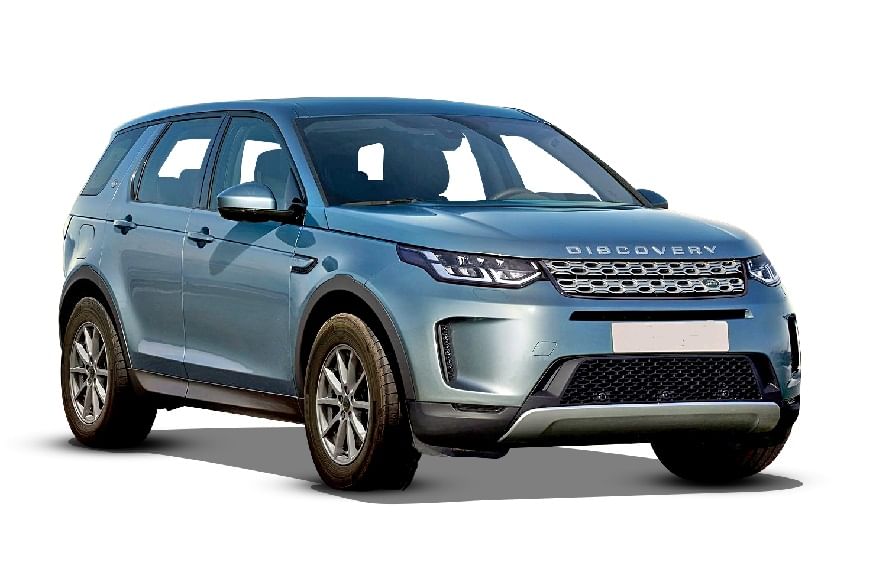

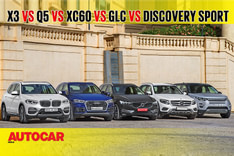

Comments
Member Login
Personal Details
No comments yet. Be the first to comment.